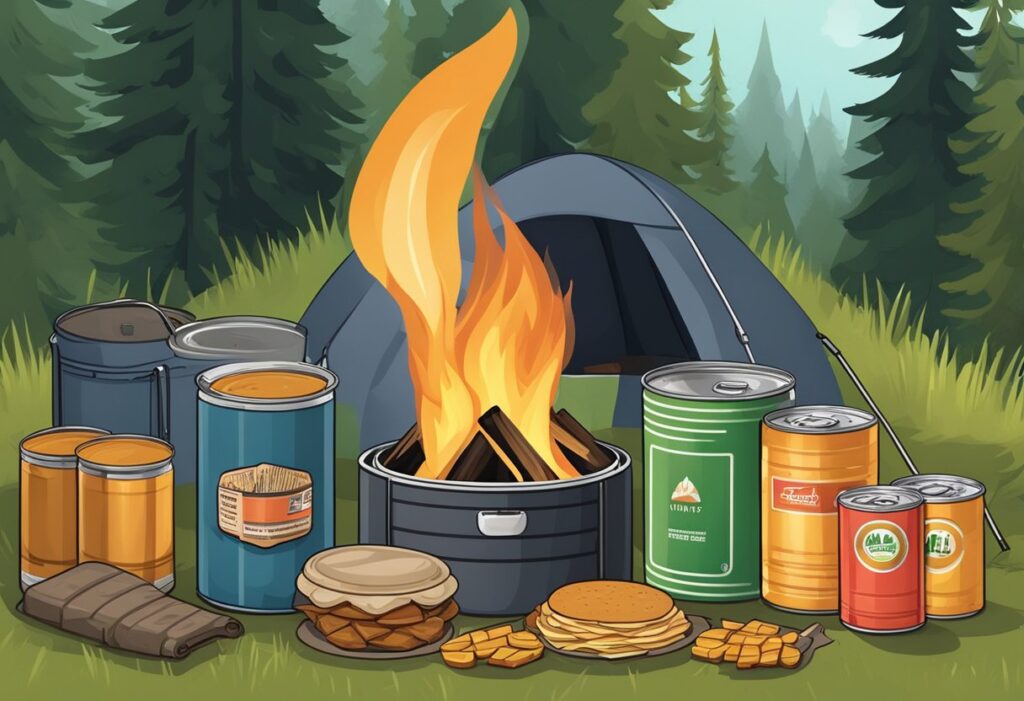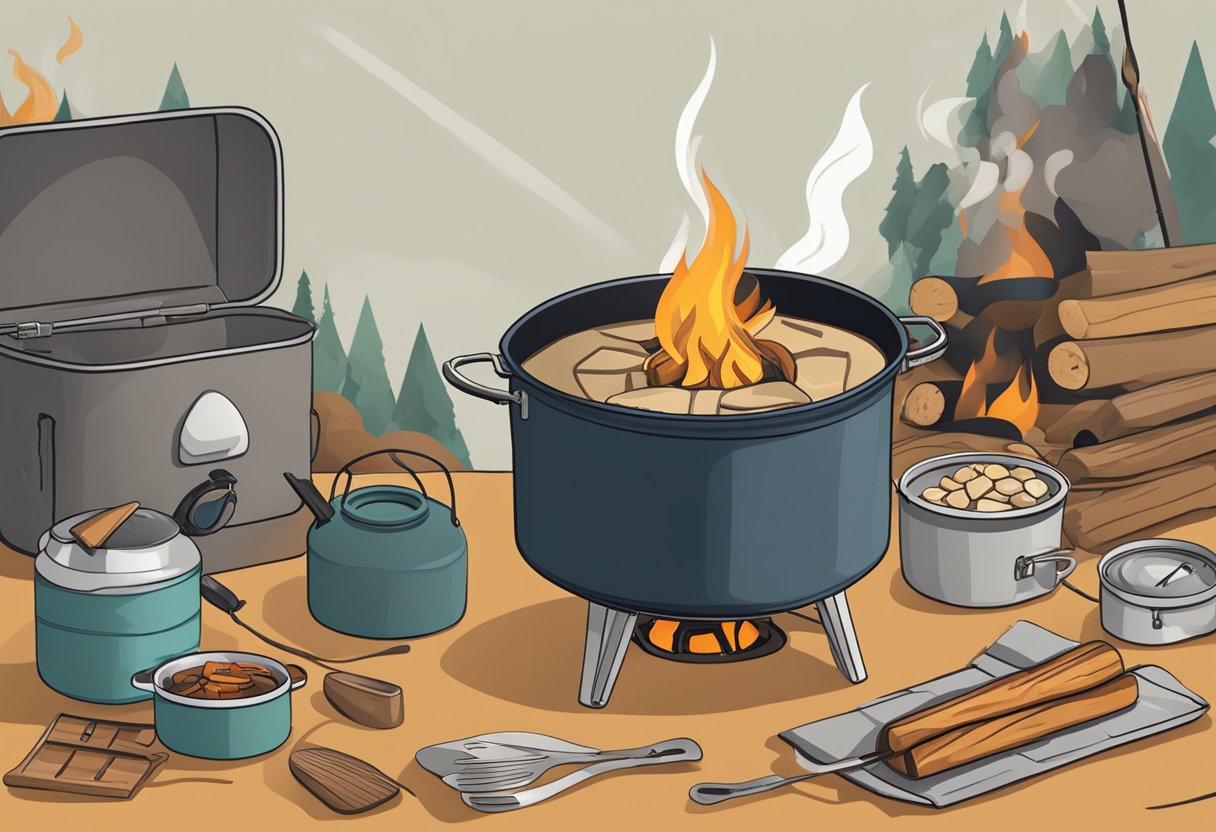Camping is a great way to get away from the hustle and bustle of everyday life. However, preparing food while camping can be a challenge. One solution to this problem is to bring canned food for camping. Canned food is a convenient and shelf-stable option that requires no refrigeration, making it perfect for camping trips.

Canned food for camping comes in a variety of options, from canned meat and vegetables to canned soups and fruits. These options provide a range of nutrition and flavor to keep campers fueled and satisfied. Additionally, canned food is easy to pack and transport, making it a popular choice for outdoor enthusiasts.
When selecting canned food for camping, it is important to consider the nutritional content of the food. While canned food can be a convenient option, it can also be high in sodium and preservatives. It is important to choose canned food options that are low in sodium and high in nutrients to ensure a balanced diet while camping. Overall, canned food for camping is a convenient and practical option for outdoor enthusiasts looking for an easy and nutritious meal option while enjoying the great outdoors.
Choosing Canned Foods for Camping
When it comes to camping, canned foods are a great option to consider. They are easy to pack, don’t require refrigeration, and can provide a good source of nutrition. However, not all canned foods are created equal. Here are some tips for choosing the best canned foods for camping.
Protein-Packed Options
Protein is an essential nutrient that is important for maintaining muscle mass and keeping you feeling full. Canned meats such as chicken, tuna, and spam are great sources of protein and can be used in a variety of meals. Canned beans are also a good option for vegetarians and vegans. They are high in protein and can be used in soups, stews, and chili.
Vegetables and Fruits
Canned vegetables and fruits are a great way to add some variety to your camping meals. They can be used as a side dish or added to soups and stews. Canned fruit can be used as a dessert or snack. Look for options that are low in sugar and packed in water or juice instead of syrup.
Hearty Meals and Soups
Canned soups and meals are a convenient option for camping. They are easy to prepare and can be a satisfying meal after a long day of hiking or exploring. Look for options that are low in sodium and high in protein and fiber. Some popular options include canned chili, beef stew, and chicken noodle soup.
In conclusion, canned foods can be a great option for camping. When choosing canned foods, look for options that are high in protein, low in sodium, and packed in water or juice. With the right selection of canned foods, you can enjoy delicious and nutritious meals on your camping trip.
Meal Planning with Canned Goods
When it comes to meal planning for camping trips, canned goods are a convenient and practical option. They are shelf-stable and don’t require refrigeration, making them perfect for outdoor adventures. In this section, we’ll explore some ideas for using canned goods to create delicious and satisfying meals for breakfast, lunch, and dinner.
Breakfast Ideas
Breakfast is the most important meal of the day, and with canned goods, it’s easy to whip up a hearty and nutritious meal. Here are some ideas:
- Canned fruit: Fruit cocktail, peaches, and pineapples are all great options for a quick and easy breakfast. Simply open the can and serve with yogurt or oatmeal.
- Canned beans: Beans are a great source of protein and can be used in a variety of breakfast dishes. Try making a breakfast burrito with canned black beans, scrambled eggs, and cheese.
- Canned meat: Spam and corned beef hash are classic camping breakfasts. Fry them up in a pan and serve with eggs and toast.
Lunch Selections
Lunch is a great time to take a break from hiking or other outdoor activities and refuel with a satisfying meal. Here are some ideas for using canned goods for lunch:
- Canned pasta: Ravioli, spaghetti, and other canned pasta dishes are a quick and easy lunch option. Simply heat up the can on a camping stove and serve with bread or a side salad.
- Canned meat: Canned chicken, tuna, and salmon are all great options for making sandwiches or wraps. Add some mayo, mustard, and your favorite veggies for a delicious and filling lunch.
- Snacks: Don’t forget to pack some canned snacks like Vienna sausages, sardines, or pickles to munch on throughout the day.
Dinner Delights
Dinner is the main event when it comes to camping meals, and canned goods can be used to create a variety of delicious dishes. Here are some ideas:
- Canned soup: Soup is a great option for a quick and easy dinner. Simply heat up the can and serve with bread or crackers.
- Canned vegetables: Corn, peas, and green beans are all great options for adding some veggies to your dinner. Simply heat up the can and serve as a side dish.
- Canned meat: Canned beef stew, chili, and chicken noodle soup are all great options for a hearty and filling dinner. Serve with bread or rice for a complete meal.
In conclusion, canned goods are a versatile and practical option for meal planning when camping. With a little creativity, you can create delicious and satisfying meals for breakfast, lunch, and dinner using canned goods.
Maximizing Flavor and Variety
When it comes to camping, having a variety of flavors in your meals can make all the difference. Canned foods are not only convenient, but they also provide a range of flavors and textures that can make your camping trip more enjoyable. Here are some tips to maximize the flavor and variety of your canned food meals:
Spices and Sauces
One way to add flavor to canned foods is by using spices and sauces. Many canned foods, such as canned chili and canned salmon, can be enhanced with the right combination of spices. For example, adding cumin and chili powder to canned chili can give it a smoky and spicy flavor. Similarly, adding lemon pepper to canned salmon can enhance its natural flavor.
Sauces can also be used to add flavor to canned foods. Tomato sauce and pasta sauce are great options for adding flavor to canned vegetables and meats. Simply heat up the sauce and mix it in with your canned food for a quick and easy meal.
Combining Fresh and Canned Ingredients
Another way to add variety to your canned food meals is by combining fresh and canned ingredients. For example, you can mix canned vegetables with fresh herbs and spices to create a flavorful side dish. You can also use canned meats, such as canned chicken, to add protein to a fresh salad.
By combining fresh and canned ingredients, you can create meals that are both flavorful and nutritious. Plus, using fresh ingredients can help add variety to your camping meals, which can help prevent meal fatigue.
Overall, there are many ways to maximize the flavor and variety of your canned food meals while camping. By using spices and sauces, and combining fresh and canned ingredients, you can create meals that are both delicious and satisfying.
Cooking Techniques and Equipment

Camp Stove Essentials
When it comes to cooking canned food while camping, a camp stove is a must-have item. There are several types of camp stoves available on the market, including butane, propane, and liquid fuel stoves. Butane stoves are lightweight and easy to use, while propane stoves are more versatile and can handle larger pots and pans. Liquid fuel stoves are ideal for cold weather camping, as they perform well in low temperatures.
When using a camp stove, it’s important to have the right cookware and utensils. A lightweight and compact set of cookware is ideal for camping. It should include a pot, a frying pan, and a kettle. Additionally, a set of cooking utensils, such as a spatula, tongs, and a ladle, is essential. A can opener is also a must-have item, as it allows you to open canned food easily.
No-Cook Canned Food Options
While a camp stove is essential for cooking canned food while camping, there are also several no-cook options available. These options are ideal for those who want to save time and energy, or for those who don’t have access to a camp stove.
Some no-cook canned food options include canned fruit, canned vegetables, canned beans, and canned tuna. These items can be eaten straight out of the can, or they can be mixed with other ingredients to create a salad or sandwich. Another option is to use a Dutch oven to heat up canned food over a campfire. This method is ideal for those who prefer a hot meal but don’t have access to a camp stove.
Overall, there are several cooking techniques and equipment options available for cooking canned food while camping. Whether you choose to use a camp stove or opt for a no-cook option, it’s important to have the right tools and equipment to make your camping trip a success.
Storing and Managing Canned Foods While Camping
Canned foods are a popular choice for camping trips due to their convenience, long shelf life, and ability to withstand a variety of weather conditions. Here are some tips for storing and managing canned foods while camping:
1. Keep canned foods in a cool, dry place
Canned foods should be kept in a cool, dry place to prevent spoilage and maintain their quality. If possible, store canned foods in a cooler with ice packs or in a shaded area. Avoid leaving canned foods in direct sunlight or in a hot car, as this can cause the food to spoil more quickly.
2. Choose non-perishable canned foods
When selecting canned foods for camping, choose non-perishable options that do not require refrigeration. This includes canned meats, fruits, vegetables, and soups. These items have a long shelf life and can be safely stored for extended periods of time.
3. Purchase canned foods at a grocery store
When purchasing canned foods for camping, it is best to buy them at a grocery store rather than a convenience store or gas station. Grocery stores typically have a larger selection of canned foods and offer better prices.
4. Store canned foods in plastic containers
To prevent damage to canned foods during transport, store them in plastic containers rather than paper bags. Plastic containers are more durable and will protect the cans from being crushed or punctured.
5. Label canned foods for easy identification
Labeling canned foods with the contents and expiration date can help campers keep track of their food supply and prevent waste. Use a permanent marker or label maker to clearly mark each can.
By following these tips, campers can safely store and manage their canned food supply while enjoying their outdoor adventures.